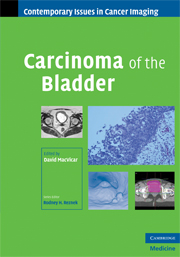Book contents
- Frontmatter
- Contents
- Contributors
- Series foreword
- Preface to Carcinoma of the Bladder
- 1 The pathology of bladder cancer
- 2 Clinical features of bladder cancer
- 3 Imaging in the diagnosis of bladder cancer
- 4 Radiological staging of primary bladder cancer
- 5 Imaging of metastatic bladder cancer
- 6 Surgery for bladder cancer
- 7 External beam radiotherapy for the treatment of muscle invasive bladder cancer
- 8 The chemotherapeutic management of bladder cancer
- 9 Clinical follow-up of bladder cancer
- 10 Imaging of treated bladder cancer
- Index
- Plate section
- References
10 - Imaging of treated bladder cancer
Published online by Cambridge University Press: 25 August 2009
- Frontmatter
- Contents
- Contributors
- Series foreword
- Preface to Carcinoma of the Bladder
- 1 The pathology of bladder cancer
- 2 Clinical features of bladder cancer
- 3 Imaging in the diagnosis of bladder cancer
- 4 Radiological staging of primary bladder cancer
- 5 Imaging of metastatic bladder cancer
- 6 Surgery for bladder cancer
- 7 External beam radiotherapy for the treatment of muscle invasive bladder cancer
- 8 The chemotherapeutic management of bladder cancer
- 9 Clinical follow-up of bladder cancer
- 10 Imaging of treated bladder cancer
- Index
- Plate section
- References
Summary
Imaging has a well-established role in the pre-treatment assessment of bladder cancer. Staging of muscle invasive tumors with CT or MRI is accurate and has an immediate effect on treatment decisions [1–3]. However, the role of imaging in monitoring the effects of treatment and in the follow-up of the treated patient is less well defined.
This chapter will consider the role of imaging in the diagnosis of treatment-related complications, the recognition of normal post-treatment tissue appearances and the assessment of treatment response as well as the role of imaging in patient follow-up and the diagnosis of local tumor recurrence.
Although a small number of patients have other pathologies, the vast majority of bladder cancers are transitional cell carcinomas (TCC), and this chapter will focus solely on this tumor type. The choice of treatment modality in bladder cancer is dependent on many factors; the most important are the stage and histological grade of the tumor, but other important factors include the patient's performance status and co-morbidities, patient preference and the preference and expertise of the treatment center. There are large geographical variations in treatment preferences; in particular, patients with muscle invasive tumors are more likely to be treated with radiotherapy in the UK, compared with the United States.
Imaging following surgery
Transurethral resection and biopsy
Over 80% of bladder cancer patients have superficial (non–muscle invasive) tumors. These patients are usually treated by transurethral resection of the bladder tumor (TURBT).
- Type
- Chapter
- Information
- Carcinoma of the Bladder , pp. 147 - 173Publisher: Cambridge University PressPrint publication year: 2008

